
When trying to identify a Miura as being an early or late model, or even a P400, S, or SV, the classification is complicated because many owners (and even the factory) have upgraded cars with newer features. I know of one P400 that was upgraded to an SV by the factory, and at least two SV's with some P400 features (eyelashes and driving lamps). My own P400 is being upgraded to an S so thoroughly that it will be very difficult to tell it's not a factory S. Serial numbers are not definitive, since there are factory S cars with lower serial numbers than mine. Also, be wary of photos in books. Almost every Lamborghini book I have (and I have many) misidentifies one or two photos. For details on the evolution of the Miura, click the links in the left menu.
With most collector cars, the more original, the more valuable, but the collector world has been divided on how this applies to the Miura. Almost from the start, Miura owners updated their cars with the latest improvements. For decades Miuras were upgraded with improved chassis modifications, vented brakes, split engine sump, etc. Applying a factory upgrade faithfully to a car truly improves the car, making it more comfortable and beautiful while improving the handling and reliability.
Regardless of the school of thought, these cars are regarded as the first true supercars and there values can rage from $500,000 to $2,000,000
Production figures:
P400 1966-1969 (474)
P400S 1968-1971 (140)
P400SV 1971-1972 (150)

 To request an appraisal, please complete the sections below:
To request an appraisal, please complete the sections below: